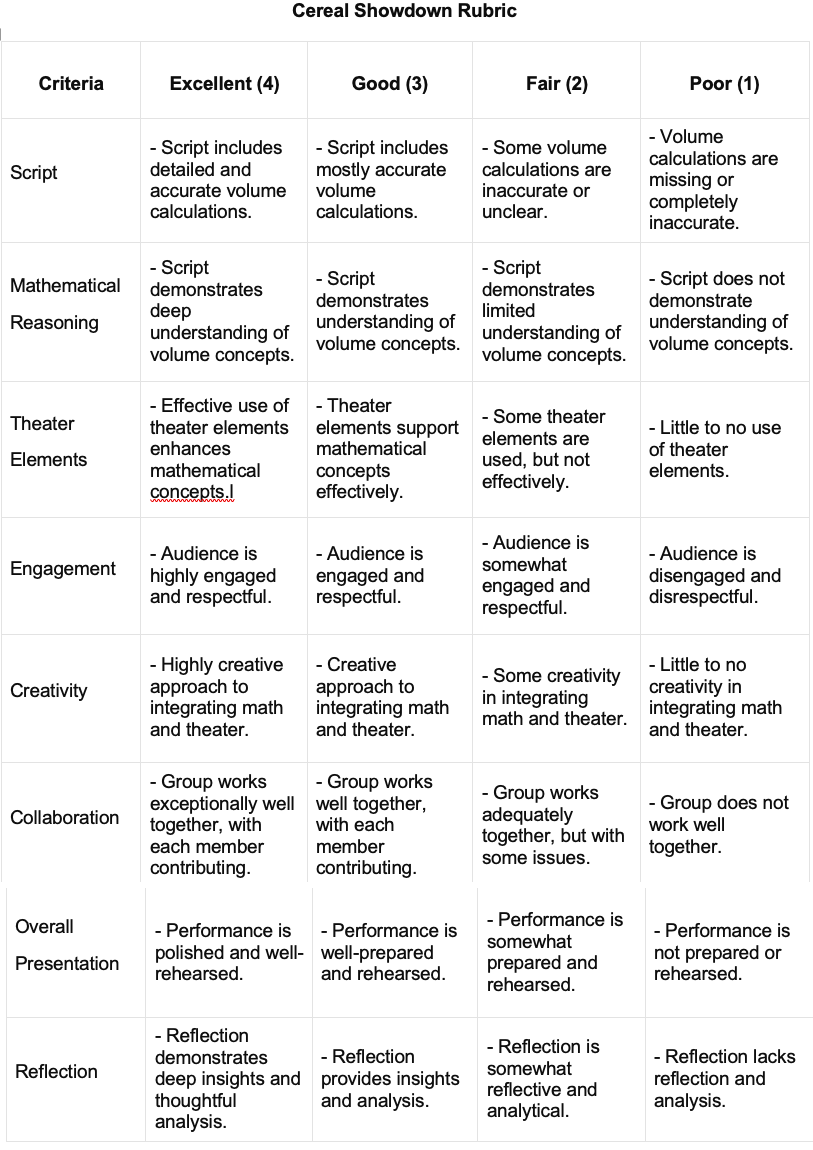VOLUME OF RIGHT RECTANGULAR PRISMS : DISCOVERING VOLUME THROUGH CHOREOGRAPHY 5
VOLUME OF RIGHT RECTANGULAR PRISMS: DISCOVERING VOLUME THROUGH CHOREOGRAPHY
Learning Description
In this lesson, students will discover how the volume of a right rectangular prism can be found by creating choreography to represent the formula for volume.
Learning Targets
"I Can" Statements
“I Can…”
- I can find the volume of a right rectangular prism.
- I can create a piece of choreography to demonstrate how to find the volume of a right rectangular prism.
Essential Questions
- How can I create a piece of choreography that demonstrates how to find the volume of a right rectangular prism?
- How can I find the volume of a rectangular prism?
Georgia Standards
Curriculum Standards
5.GSR.8.3 Investigate volume of right rectangular prisms by packing them with unit cubes without gaps or overlaps. Then, determine the total volume to solve problems.
Arts Standards
ESD5.CR.1 Demonstrate an understanding of the choreographic process.
ESD5.CR.2 Demonstrate an understanding of dance as a form of communication.
South Carolina Standards
Curriculum Standards
5.MDA.3 Understand the concept of volume measurement.
a. Recognize volume as an attribute of right rectangular prisms;
b. Relate volume measurement to the operations of multiplication and addition by packing right rectangular prisms and then counting the layers of standard unit cubes;
c. Determine the volume of right rectangular prisms using the formula derived from packing right rectangular prisms and counting the layers of standard unit cubes.
Arts Standards
Anchor Standard 1: I can use movement exploration to discover and create artistic ideas and works.
Anchor Standard 2: I can choreograph a dance.
Key Vocabulary
Content Vocabulary
- Volume - The amount of space occupied by a three-dimensional object or shape
- Height - The perpendicular distance from the base of a shape or object to its topmost point
- Length - The distance from one end of an object to the other along its longest side
- Width - The measurement of the shorter side of an object or shape when compared to its length; it is usually the horizontal dimension
- Three-dimensional figure - A figure that has length, width, and height
Arts Vocabulary
- Choreography - The art of designing and arranging sequences of movements, steps, and gestures to create a dance piece
- Levels - One of the aspects of movement (there are three basic levels in dance: high, middle, and low)
- Locomotor - a movement that travels through space
- Non-locomotor - A movement that does not travel through space
- Rhythm - The pattern of timed beats and movements that align with the music
Materials
- Volume equations
- Music (optional) for students performances (upbeat instrumental music is recommended)
- Rubric (see “summative assessment”)
Instructional Design
Opening/Activating Strategy
- Explain to students that different levels can be used in choreography to communicate different ideas.
- Have students get into a circle facing each other. Explain to them that they will follow your movements.
- Start showing them one movement and have them copy you to the rhythm of a steady beat.
- Change the movement to one of a different level. Explain to students that there are levels in dance–high, medium, low. Now, put the two movements together.
- Next add locomotor movement moving either to the side, front, or back. Put the three movements together and have students follow along. Explain that when we put movements together, we create choreography.
- Allow students to take turns being the “leader” showing a new movement that the class will follow. Encourage them to utilize levels and locomotor movement to add variety.
Work Session
- Next, explain to the students that they will be using choreography to help them understand and remember how to find the volume of right rectangular prisms.
- Address the misconception that volume is the same as area.
- Divide the students into small groups.
- Instruct students to create a movement sequence that demonstrates the formula for finding volume.
- Students must create a movement for length, width, height, and volume as well as a movement to show “multiply” and “equal”. Students will have seven movements total in their choreography.
- Students must use levels and locomotor and non-locomotor movements in their choreography.
- Monitor student work by circulating and providing guidance as needed.
- After groups have choreographed their movement sequences, assign each group three volume equations to solve. Students should use the formula to solve each equation.
Closing Reflection
- As a class, ask students to share one thing they learned about finding volume through choreography. This can be done as a whole class or with a neighboring student.
- Ask students how they used choreography as a tool of communication in this lesson.
Assessments
Formative
- Ask questions throughout the process to assess whether the students understand volume.
- Make observations of the choreographic process to ensure the students are using the dance vocabulary and applying it to the task in a meaningful way.
Summative
- Student work on the three volume equations
- Rubric for choreography:

DIFFERENTIATION
|
Accelerated: Challenge students to create their own choreography sequence that represents a different geometric shape. Instruct them to write down the corresponding volume formula and steps to find the volume of the shape they created. Remedial:
|
CREDITS
U.S. Department of Education- STEM + the Art of Integrated Learning
Ideas contributed by: SAIL Grant Teacher Leaders
*This integrated lesson provides differentiated ideas and activities for educators that are aligned to a sampling of standards. Standards referenced at the time of publishing may differ based on each state’s adoption of new standards.
Revised and copyright: June 2025 @ ArtsNOW


